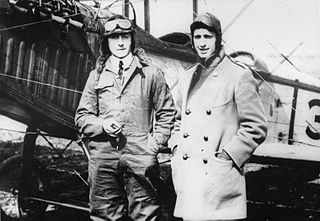Related Research Articles
Robert Alexander Little,, a World War I fighter pilot, is generally regarded as the most successful Australian flying ace, with an official tally of forty-seven victories. Born in Victoria, he travelled to England in 1915 and learned to fly at his own expense before joining the Royal Naval Air Service (RNAS). Posted to the Western Front in June 1916, he flew Sopwith Pups, Triplanes and Camels with No. 8 Squadron RNAS, achieving thirty-eight victories within a year and earning the Distinguished Service Order and Bar, the Distinguished Service Cross and Bar, and the French Croix de guerre. Rested in July 1917, he volunteered to return to the front in March 1918 and scored a further nine victories with No. 3 Squadron RNAS before he was killed in action on the night of 27 May, aged twenty-two.
Captain Thomas Frederic Williams MC was a Canadian First World War flying ace, officially credited with 14 victories.

Air Vice Marshal George Roberts Howsam, CB, MC was a Canadian First World War flying ace, officially credited with 13 victories. Serving in the newly formed Royal Canadian Air Force in the inter-war years, Howsam served as the RCAF's Director of Training during World War II.

Captain Ernest Charles Hoy DFC was a Canadian First World War flying ace, officially credited with 13 victories. He later pioneered airmail flight over the Canadian Rockies.
Captain Hazel LeRoy Wallace DFC was a Canadian First World War flying ace, officially credited with 14 victories. His record shows him to have been a notable team player in squadron tactics.
Captain Earl McNabb Hand was a Canadian World War I flying ace credited with five confirmed aerial victories and two unconfirmed ones.
Air Commodore Redford Henry Mulock, was a Canadian aviator and flying ace. He was the first Canadian flying ace of the First World War and the first in the Royal Naval Air Service, achieving five aerial victories by May 1916.
Herbert Gardner Travers, was a British flying ace of the First World War, credited with five aerial victories. He later worked in civil aviation and returned to service during the Second World War.
Captain John William Pinder DFC was a British First World War flying ace, who flew for the Royal Navy Air Service, and later the Royal Air Force.
Lieutenant Earl Frederick Crabb was a World War I flying ace credited with six aerial victories. After World War I, he was an aviation pioneer and bush pilot. He returned to military aviation during World War II. He flew as a commercial pilot until he was 72 years old.
Ronald Turnbull Mark, was a British flying ace of the First World War who was credited with 14 aerial victories.
Harold Alan Hamersley MC was an Australian World War I flying ace credited with 13 confirmed aerial victories. He later went on to serve in the Royal Air Force following the war, serving in India and reaching the rank of group captain before retiring.
Captain Stanley Stanger was a World War I flying ace credited with 13 confirmed aerial victories scored on the Italian Front. He was also noted for his ingenious escape from being captured by the Austro-Hungarians.
Captain William Stanley Jenkins was a Canadian flying ace during World War I. He was officially credited with 12 aerial victories, having scored his first two while still on sick leave.
Captain James Henry Forman DFC was a World War I Canadian flying ace credited with nine aerial victories. He was personally decorated by his king for his valor. After leaving military service in the 1920s, he would return to service in World War II.
Group Captain Acheson Gosford Goulding was a Canadian World War I flying ace credited with 21 aerial victories. After infantry service, he transferred to aviation and served in Asia Minor and the Balkans. After winning the Military Cross for courage, he returned to civilian life. He gave up a business career to return to service for World War II as a Group Captain. *aerial victories source: Manitoba Historical Society.
Alfred Alexander Leitch was born on 5 February 1894 in Killarney, Manitoba, Canada. He grew into a tall young man. He enlisted in the Canadian Expeditionary Force on 15 May 1917 as an unmarried student. Upon his enlistment, he designated his next of kin as Mary J. Leitch of Winnipeg, Manitoba, Canada. He was accepted for military service despite having a deformed foot.
Lieutenant Malcolm Plaw MacLeod (1897-1960) was a Canadian flying ace. He was credited with seven aerial victories scored during the closing days of World War I. He then returned to Canada to complete his education and work as a stockbroker until World War II, when he served in the Royal Canadian Air Force for the war's duration.
Squadron Leader Roy Kirkwood McConnell was a World War I flying ace from Canada credited with seven aerial victories. His award of the Distinguished Flying Cross noted both aerial victories, as well as gallantry in hazardous ground attack missions.
Merrill Samuel Taylor was a Canadian flying ace of the First World War. He was credited with seven aerial victories while flying a Sopwith Camel fighter for the Royal Naval Air Service and, later, the Royal Air Force. He touched off the air battle that resulted in the death of the war's leading ace, Manfred von Richthofen, on 21 April 1918. On 2 May 1918, he killed German ace Hans Weiss for his fifth victory. Taylor was killed in action by Franz Büchner on 7 July 1918.
References
- Above the Trenches: A Complete Record of the Fighter Aces and Units of the British Empire Air Forces 1915-1920. Christopher F. Shores, Norman L. R. Franks, Russell Guest. Grub Street, 1990. ISBN 0-948817-19-4, ISBN 978-0-948817-19-9.